Plants add life, light, and warmth to the interior design of a home. And, if you want to increase the visual appeal of your indoor plant collection, why not replace your green plants with purple ones. You cannot go wrong with a purple house plants, whether you choose one with a solid purple color, one with flecks of violet, or one with blossoms the color of dazzling amethyst. They all look stunning and add a royal touch to your interior space.
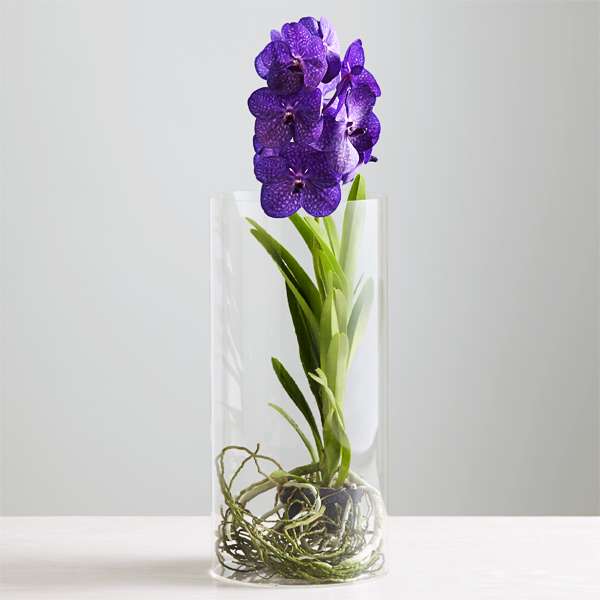
Purple vanda orchids are one of the most popular orchid varieties because of their scent, many flowers, and striking purple-colored flowers.
I will be completely honest! Hardly every plant can have fully purple leaves from the ground up. So we have cast our net a little wider to provide you with as many choices as possible.
There’s something here for everyone, whether you’re a purist about purple velvet plants and want nothing but pure purple ones or you’re just looking for some purplish architectural shape and structure to add to the variety of houseplants in your interior space.
Purple flowers and plants symbolize monarchy and tradition. Purple can also represent achievement and sentiments of appreciation. In addition, various purple flowers and plants have developed unique symbolic connotations of their own.
For instance, the Buddhist purple lotus denotes spirituality, the Christian purple violet indicates prayer, and the Chinese evergreen represents good luck.
Anyway, you are here because you want purple houseplants, so let’s get to it.
Most Beautiful Purple Plants For Homes
Purple houseplants are a beautiful and fun addition to any plant collection, and they can really make a home come to life. In this section, I will cover my top picks for the most beautiful purple houseplants and provide some advice on how to care for them.
1. Wandering Jew

Does this look like a plant you might want in your home? If yes, click here.
A very common plant that can be easily propagated and has an attractive appearance when grown in a hanging basket or when trained to grow in a topiary form.
The upper surfaces of its leaves have a distinctive olive color with silver marks, while the lower surfaces are purple. Some variants have leaves that are purple on both sides.
Also known as the inch plant, it features tiny purple blossoms. Furthermore, it forms colonies when it spreads and is frequently used as a ground cover in outdoor settings.
Wandering Jew Features & Basic Care
| Botanical Name | Tradescantia zebrina |
| General Care | Low to moderate |
| Toxicity | Non-toxic to pets and people |
| Size & Growth | Fast-growingReaches lengths of up to 24 inches and heights of 6 to 12 inches |
| Blooms | Small flowers |
| Propagation | Stem cuttings or leaves |
| Fertilization | Water-soluble fertilizer applied monthly at half strength |
| Watering | Water regularly |
| Humidity & Temperature | Moderate humidity, 50 °F to 80 °F |
| Light Requirements | Bright but indirect sunlight |
| Ideal Soil Type | Rich, well-draining, loamy soil |
Related: 12 Types of Popular Tradescantia Wandering Jew Plants with Pictures
2. Bellflower
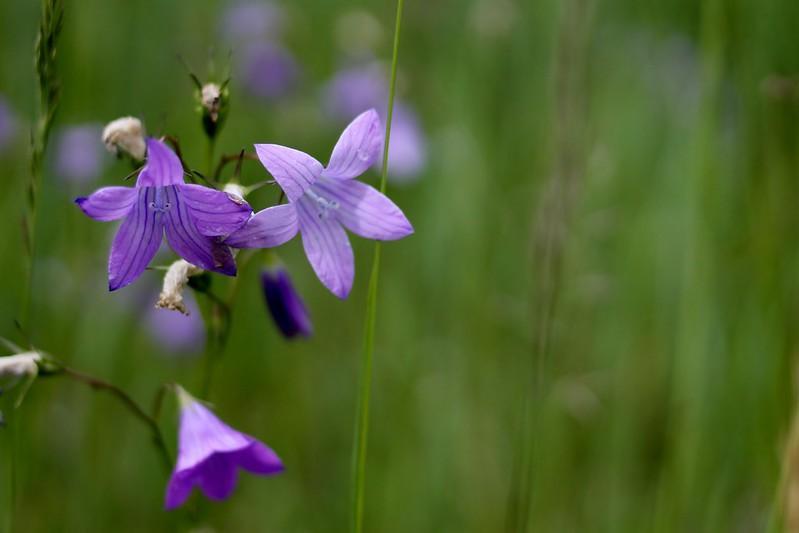
Does this look like a plant you might want in your home? If yes, click here.
Campanula, from the Latin meaning “small bell,” is the common name for the plants of the genus Campanula, which bloom in a purplish blue color.
There is no better plant for a low-maintenance cottage garden than the bellflower. Bellflowers bloom mostly in June and July; however, some places have flowers until October. Bellflowers thrive best in USDA plant hardiness zones four and up but can be grown in zone 3 with some care.
They can survive harsh winters and make for good decor in colder climates. In addition, once established, bellflowers can survive in dry conditions with little water.
Bellflowers Features & Basic Care
| Botanical Name | Genus Campanula |
| General Care | Under the right conditions, they are very easy to grow |
| Toxicity | Non-toxic to pets and people |
| Size & Growth | 8 inches wide and 6 inches tall is typical for a fully mature plant |
| Blooms | Abundant and small bell-shaped flowers |
| Propagation | Seeds and cuttings |
| Fertilization | Apply a balanced fertilizer once in early spring |
| Watering | Water when the top inch dries up & maintain a well-drained soil |
| Humidity & Temperature | High humidity and temperatures between 65 °F and 70 °F |
| Light Requirements | Full sun to partial shade |
| Ideal Soil Type | Soil with an average pH of 6 to 8 and good drainage |
3. Bromeliad Aechmea “Blue Rain”
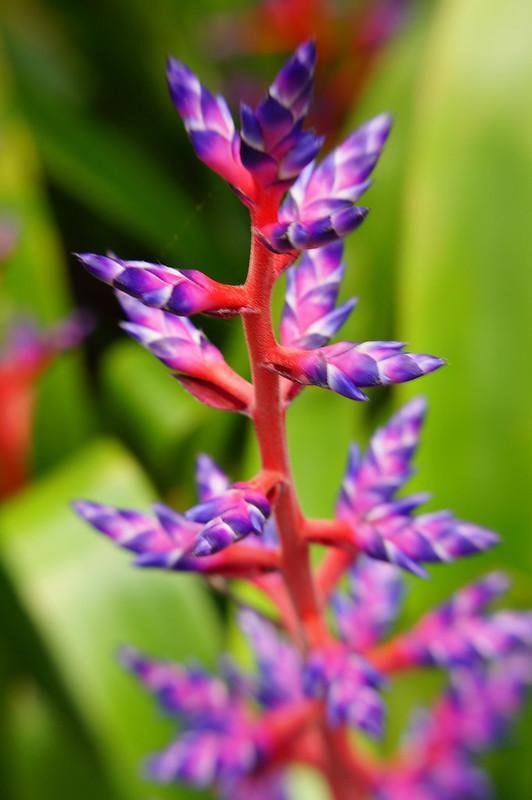
Does this look like a plant you might want in your home? If yes, click here.
There are roughly 250 different species of tropical flowering plants in the genus Aechmea, which all belong to the bromeliad family.
All bromeliads, regardless of species, have an untamed, tropical appearance. In particular, the Aechmea ‘Blue Rain‘ Bromeliad has a stunning central flowering spike of flaming red and beautiful purple blossoms.
However, in spite of their seemingly far-flung origins, Aechmea bromeliads are actually relatively easy to grow. Furthermore, these plants are epiphytic, which means they grow on a tree or other host without parasitizing it. However, you can buy them at most flower shops and nurseries as potted, terrestrial plants.
Bromeliad Aechmea “Blue Rain” Features & Basic Care
| Botanical Name | Aechmea fasciata |
| General Care | Under the right conditions, relatively easy to grow |
| Toxicity | Non-toxic to pets and people |
| Size & Growth | Can grow to a height of approximately 15 inches |
| Blooms | Spiky, long-lasting, bright purple growing in the center of the plant |
| Propagation | Cuttings, divisions, and seeds |
| Fertilization | Feed monthly with half-strength, balanced liquid fertilizer |
| Watering | Maintain soil moisture but don’t get it soggyPour lukewarm water through the plant’s center crown |
| Humidity & Temperature | High levels of humidity and temperatures ranging from 65 °F to 80 °F |
| Light Requirements | Bright, indirect/filtered sunlight |
| Ideal Soil Type | A potting soil that has good drainage and low moisture |
4. Purple Passion
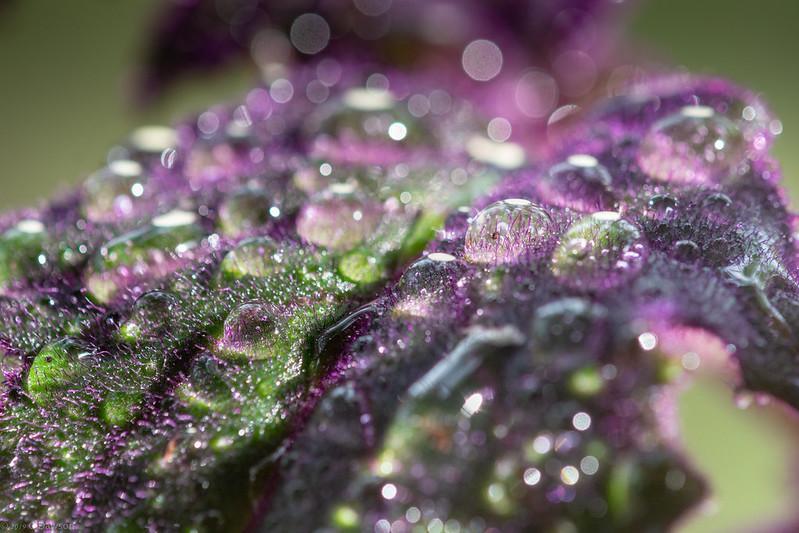
Does this look like a plant you might want in your home? If yes, click here.
The gorgeous foliage of this houseplant is green and fluffy, with a touch of purple hairs and purple edges. The plant thrives in controlled conditions and can be grown indoors year-round.
Purple passion looks best when placed in a hanging basket, where its long, velvety leaves can drape over the edge. Grow it in any neutral-colored houseplant to watch how it stands out! A native of Southeast Asia, this plant can be found all throughout the Indonesian island of Java.
When viewed in direct sunshine, the purple hairs on this plant take on an almost fluorescent quality due to their arrangement.
Purple Passion Features & Basic Care
| Botanical Name | Gynura aurantiaca |
| General Care | Simple and requiring little upkeep or effort |
| Toxicity | Non-toxic to pets and people |
| Size & Growth | 1 to 2 feet tall |
| Blooms | Orange flowers with a rather unpleasant odor |
| Propagation | Stem or leave cuttings |
| Fertilization | Fertilize weekly in spring and summer using a water-soluble fertilizer |
| Watering | Water regularly in the growing season and less frequently in fall and winter |
| Humidity & Temperature | Temperatures in the 60s and 70s with moderate humidity |
| Light Requirements | Medium to bright light |
| Ideal Soil Type | Fertile soil that drains well |
5. Ti Plant
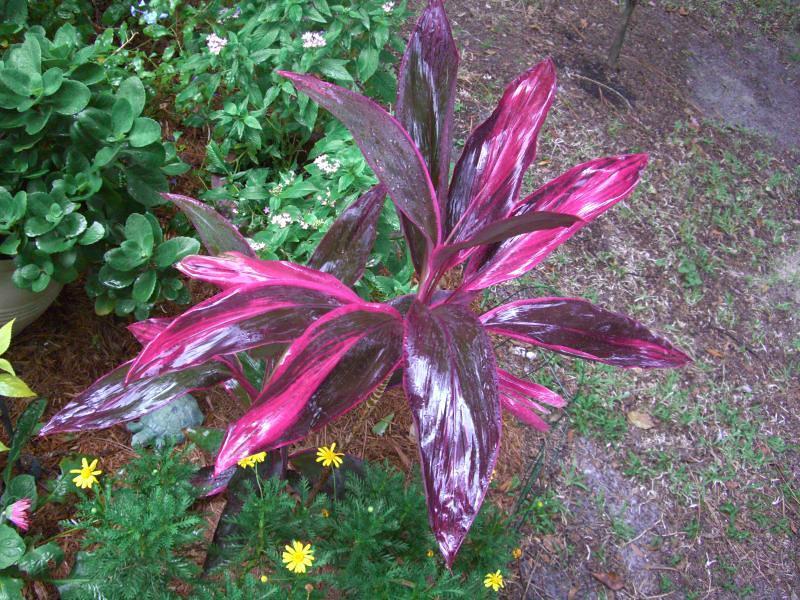
Does this look like a plant you might want in your home? If yes, click here.
The reddish-purple Ti plant is a stunning ornamental houseplant with brightly colored leaves and a stylish appearance. The Ti plant is cultivated for spiritual and therapeutic reasons and is also said to bring good fortune.
Moreover, its beautiful ornamental leaves have made it a popular houseplant all throughout the world. This plant adds color and charm to any room. Most Ti plants have strap-like leaves with vivid light and dark purple streaks.
However, some Ti plants also come with red and orange leaf varieties, so if you want to keep it as a houseplant, it’s best to seek out the purple variety.
Ti Plant Features & Basic Care
| Botanical Name | Cordyline fruticosa |
| General Care | Low to moderate maintenance |
| Toxicity | It can be toxic to pets |
| Size & Growth | Plants can grow as tall as 10 feet when fully mature. |
| Blooms | Non-showy, star-shaped, whitish-pink flowers |
| Propagation | Stem and leave cuttings |
| Fertilization | Use a controlled-release, all-purpose fertilizer during active growth |
| Watering | Maintain soil moisture with tepid filtered water during active growthReduce watering in winter and fallAvoid splashing leaves |
| Humidity & Temperature | Temperatures of 65 to 95 degrees Fahrenheit & high humidity |
| Light Requirements | Sunlight, ranging from full to partial and filtered |
| Ideal Soil Type | Well-draining, somewhat acidic, loamy/sandy potting soil |
6. African Violet
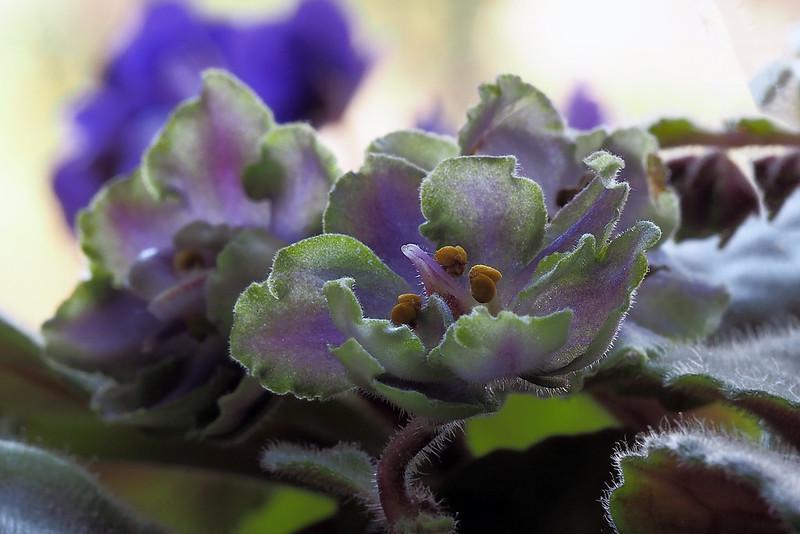
Does this look like a plant you might want in your home? If yes, click here.
The African violet produces blossoms that are a lovely purple-blue color, making any room look brighter. More importantly, though, African violets are capable of continuous blooming if given the proper care.
The plants have a wide range of luxuriant purple and green leaves and purple flowers of varying shades. Even though they are typically simple to care for, there are times when they can be difficult to handle. Please don’t let that deter you!
The key to successfully cultivating these houseplants is striking a balance between the various components involved in their upkeep which are described below.
African Violet Features & Basic Care
| Botanical Name | Saintpaulia ionantha |
| General Care | Easy to grow with the right conditions, moderately challenging overall |
| Toxicity | Non-toxic to pets and people |
| Size & Growth | Dense and small in stature. Mature plants are 8 to 16 inches across. |
| Blooms | Small, showy, star-shaped purple flowers |
| Propagation | Leaf cuttings |
| Fertilization | Feed your African violets every other week with a balanced fertilizer |
| Watering | Keep watering to keep the soil moist but not soggy |
| Humidity & Temperature | Average temperature of 70 °F and high humidity |
| Light Requirements | Indirect, bright sunlight |
| Ideal Soil Type | Porous, well-draining potting mix with a pH of 6.5 to 7.0 |
7. Moses-in-the-Cradle
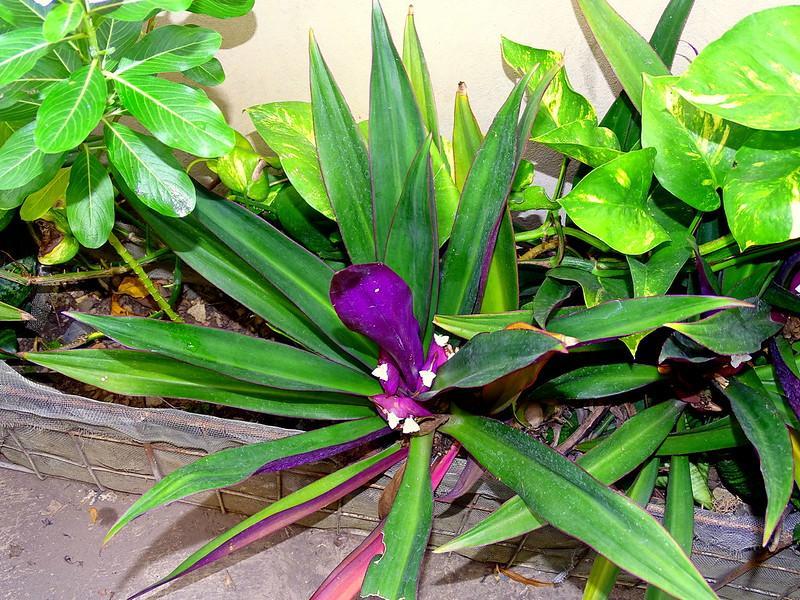
Does this look like a plant you might want in your home? If yes, click here.
Moses-in-the-cradle is known by many different names. For instance, oyster plants and boat lilies. And, if you were unable to identify the overarching theme, then you should know that neither could we.
The Moses-in-the-Cradle is characterized by a rosette of lance-shaped leaves, which are green and white striped on the upper side and flash with a brilliant purple on the underside. It grows nicely as an outdoor plant as well as a vibrant indoor plant.
However, keep an eye out for spider mites, which can rob the leaves of their color, and mealy bugs, which frequently lurk within the leaf clusters.
Moses-in-the-Cradle Features & Basic Care
| Botanical Name | Tradescantia spathacea |
| General Care | Low-maintenance and simple to care for |
| Toxicity | It can be toxic to pets and people |
| Size & Growth | It has a diameter of around 1 foot and a height of 2 feet |
| Blooms | Small, white, 3-petaled flowers |
| Propagation | Stem cuttings, root division, or seeds |
| Fertilization | In the spring & summer, feed monthly with a balanced fertilizer. |
| Watering | Likes even moisture. Water as the soil dries—water less in winter. |
| Humidity & Temperature | 60 °F to 85 °F with high humidity |
| Light Requirements | Bright and unfiltered sunlight |
| Ideal Soil Type | Soil that is both porous and has good drainage |
8. Gloxinia
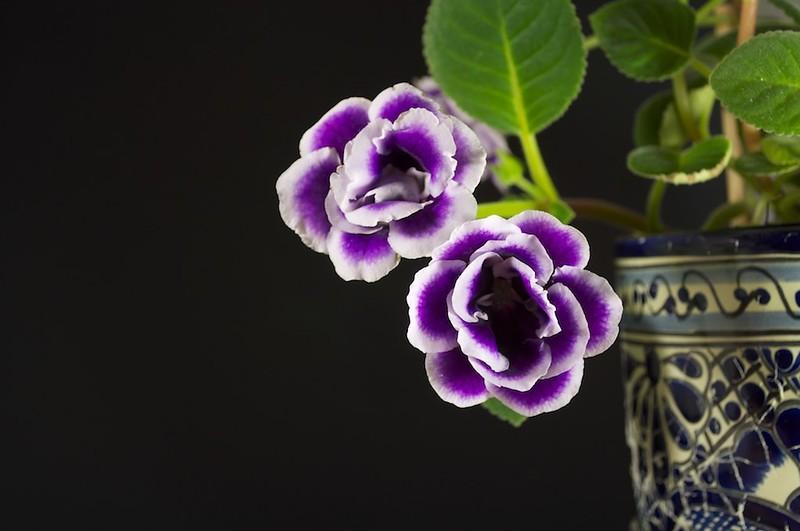
Does this look like a plant you might want in your home? If yes, click here.
Gloxinia plants are sometimes confused for African Violets due to their velvety foliage and beautiful blooms. However, gloxinia is a genus of flowering plants that is native to some parts of South America, including parts of Central America, the West Indies, and the Andes.
There are only three original species within the gloxinia genus; however, many hybrids exist and are continuously being produced.
After flowering, gloxinias require a period of rest, and the majority of gloxinias are thrown away at this point. However, if the plant is given the proper care, it can be persuaded into blooming once more.
Gloxinia Features & Basic Care
| Botanical Name | Genus Gloxinia |
| General Care | Low-maintenance and simple to grow given favorable conditions |
| Toxicity | Non-toxic to pets and people |
| Size & Growth | Mature plants can reach heights of between 6 and 12 inches. |
| Blooms | Vibrant flowers in blue, red, purple, pink, and white |
| Propagation | Seeds, roots, and leaf cuttings |
| Fertilization | Add a water-soluble fertilizer once a month during active growth |
| Watering | Keep the soil moist but not soaked.Self-watering planters are the best option. |
| Humidity & Temperature | Temperatures in the 70s to 80s Fahrenheit and high humidity |
| Light Requirements | Bright, indirect light |
| Ideal Soil Type | Loose soil that is slightly acidic and has good drainage. |
9. Purple Succulents
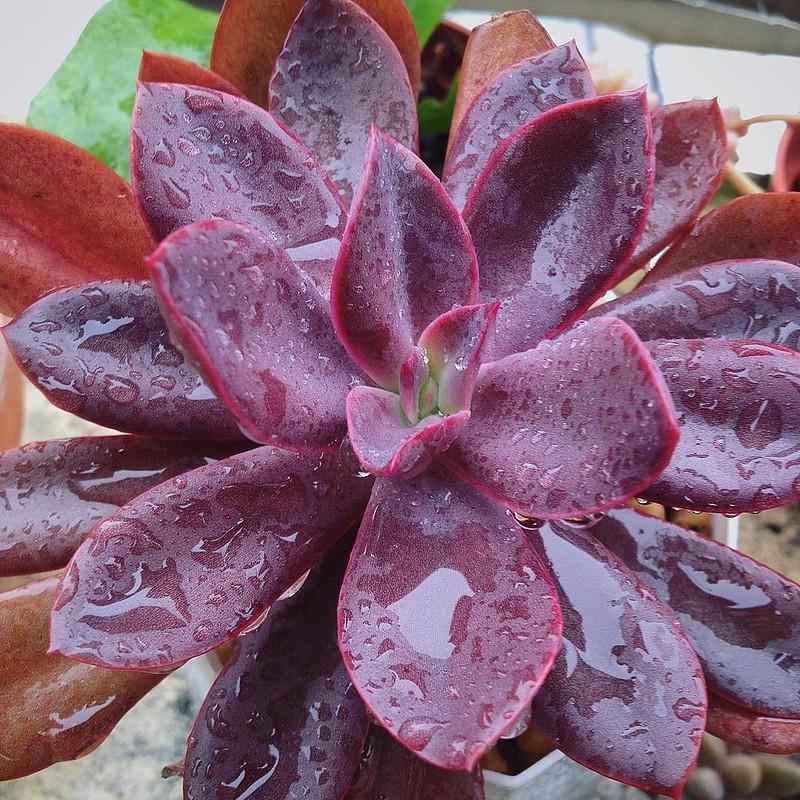
Does this look like a plant you might want in your home? If yes, click here.
There are over 150 species of rosette-shaped succulents that belong to the genus Echeveria. These plants are indigenous to the regions of Northwestern South America, Mexico, and Central America.
Purple echeverias like Dark Moon, Purple Pearl, Afterglow, and Dark Prince range in color from hazy lavender to dark, almost-black purple.
These lovely houseplants are among the most well-known rose-shaped succulents. The fleshy leaves, which have a light purple color, have margins that are waxy on the outside.
Echeveria has the same requirements for care as other succulents. You only need to give them a drink once every few weeks because of how well they retain water.
Purple Succulents Features & Basic Care
| Botanical Name | Genus Echeveria |
| General Care | Simple in terms of care and cultivation |
| Toxicity | Non-toxic to pets and people |
| Size & Growth | Size varies by species.Some grow on tall stalks, while others stay low and huge. |
| Blooms | White flowers with tiny black dots on the petals |
| Propagation | Leaves and cuttings |
| Fertilization | Avoid overfeeding.Only apply cactus/succulent fertilizer in spring or summer. |
| Watering | Needs little water. Water only when the soil is dry and let it drain. |
| Humidity & Temperature | Warm temperatures and little humidity are good for their growth. |
| Light Requirements | Direct sunlight (bright, full sun) |
| Ideal Soil Type | Soil that drains well and is pH-neutral |
10. Christmas Cactus
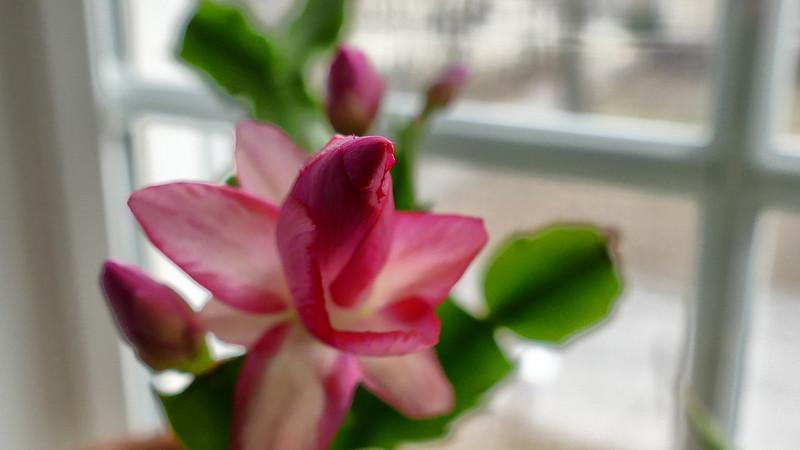
Does this look like a plant you might want in your home? If yes, click here.
Although they are technically cacti, Schlumbergera is actually a genus of plants that are exclusive to the coastline mountains of Brazil. The Christmas cactus is one of the most well-liked houseplants out there, and for a good reason.
After flowering, they reveal pink or purple tubular blossoms. They are similar to orchids in that they develop on tree bark and rocky outcroppings.
All of the holiday cactus species originate in the tropical forests of Brazil and can be planted in any season. Moreover, it is low-maintenance and spreads rapidly, making it a good contender for a holiday gift.
Christmas Cactus Features & Basic Care
| Botanical Name | Genus Schlumbergera |
| General Care | It grows with little effort and requires little upkeep. |
| Toxicity | Non-toxic to pets and people |
| Size & Growth | Achieves a height of up to 1 foot and a width of up to 2 feet |
| Blooms | Stunning pink or purple-looking flowers |
| Propagation | Leave cuttings |
| Fertilization | Feed half-strength, water-soluble fertilizer monthly until buds form. After blooming, fertilize monthly. |
| Watering | Water deeply and drain when the soil is almost dry. |
| Humidity & Temperature | Temperatures from 60c°F to 80c°F and high humidity |
| Light Requirements | Bright, filtered sunlight or a mixture of the two |
| Ideal Soil Type | Soil that is neutral to acidic, wet, and well-drained |
11. Persian Shield Plant

Does this look like a plant you might want in your home? If yes, click here.
A native of Myanmar, the Persian shield is an evergreen shrub with striking purple leaves that are crisscrossed by green veins.
The leaves can reach lengths of up to 0.5 ft. and are a welcome addition to any home. They have an iridescent shine that gives them a transparent shimmer, which makes them one of the most gorgeous purple houseplants on the list.
Persian shields can produce blooms of a lavender color given the appropriate conditions; however, flowering in indoor plants is uncommon.
Persian shield plants are versatile and may thrive in a variety of environments. Just make sure the humidity levels stay high.
Persian Shield Plant Features & Basic Care
| Botanical Name | Strobilanthes auriculatus |
| General Care | Easy to grow and requires little upkeep |
| Toxicity | Not toxic to humans or animals, but its sap can cause skin irritation |
| Size & Growth | Plants can reach heights of up to three to four feet when fully mature. |
| Blooms | Flowers occasionally in fall given the right conditions |
| Propagation | Stem or leave cuttings |
| Fertilization | Fertilize every two weeks with half-strength fertilizer in the growing season |
| Watering | When the top inch of soil dries, irrigate with filtered lukewarm water. |
| Humidity & Temperature | Temperatures above 60 °F and moderate humidity. |
| Light Requirements | Full sun to partial shade |
| Ideal Soil Type | Soil that is slightly acidic to neutral in pH is rich, moist, and drains well |
12. Purple Vanda Orchid
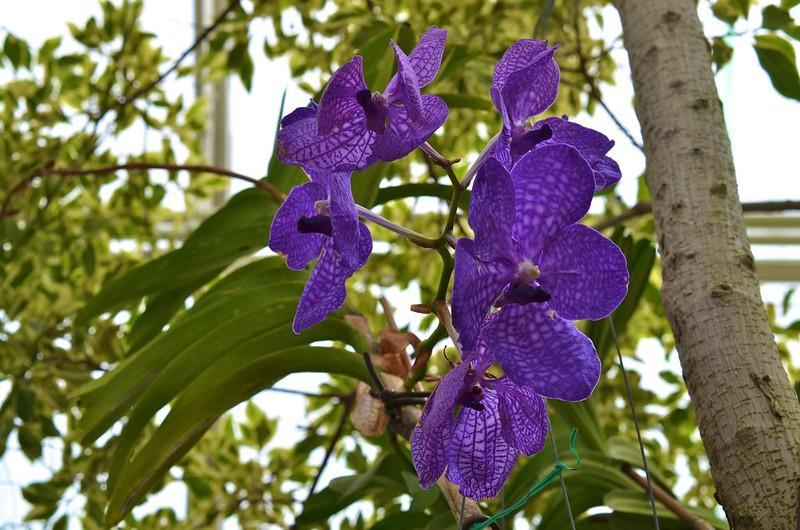
Does this look like a plant you might want in your home? If yes, click here.
About eighty different kinds of orchids belong to the genus Vanda, and their beautiful blooms come in virtually every color of the rainbow.
The Vanda orchid has some of the longest-lasting and most fragrant blossoms of any orchid species. However, while being one of the most well-known ornamental flower varieties, they are not beginner-friendly.
Most Vandas are also epiphytes. This indicates that in nature, they have a propensity to grow in spaces or crevices in the bark of trees and the joints of tree limbs. However, they can also be found growing on rocks from time to time.
Purple Vanda Orchid Features & Basic Care
| Botanical Name | Ascocentrum vanda |
| General Care | Moderately fussy, yet simple to cultivate with the appropriate conditions. |
| Toxicity | Not clear, so keep pets and children away |
| Size & Growth | Mature plants can grow to be between 1 and 3 feet tall. |
| Blooms | Purple blooms with possible pink undertones, a natural bicolor appearance |
| Propagation | Stem cuttings and seeds |
| Fertilization | Fertilize weekly in spring and summer and monthly in fall and winter. |
| Watering | Water-intensive. So, water often but let drain thoroughly. |
| Humidity & Temperature | Temperatures between 65 °F and 85 °F and high humidity |
| Light Requirements | Direct light or a bright, indirect sunlight |
| Ideal Soil Type | Inert, soil-free mediums like peat moss or bark would work nicely. |
13. Cyclamen
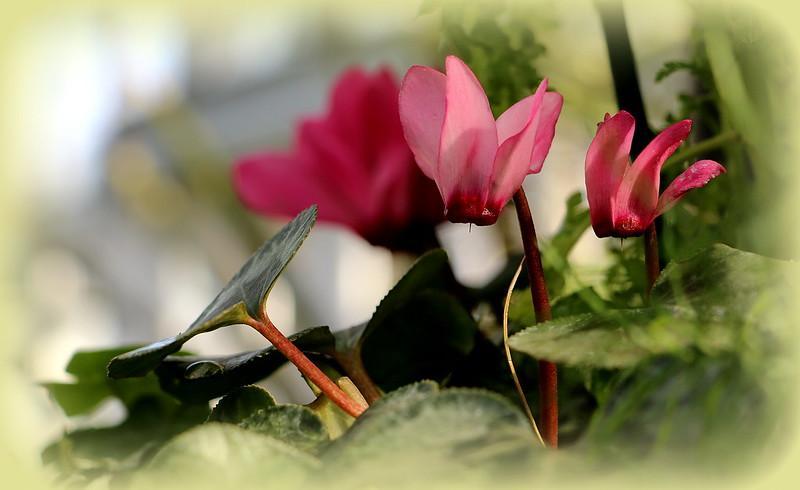
Does this look like a plant you might want in your home? If yes, click here.
There are 23 different kinds of plants that belong to the Cyclamen genus, and their flowers range in color from pink to purple. Cyclamen can bloom at any time of year, but after they do so, they must rest for a few months before they can bloom again.
They have heart-shaped leaves that are green on top and purple on the underside, and they have a lovely dappled pattern on the leaves. Cyclamens are native to the Mediterranean region.
They can thrive in a variety of temperatures, including dry, scorching summers as well as damp, cold winters. However, the cyclamen offered as houseplants are tropical and will perish in temperatures below 40 degrees Fahrenheit.
Cyclamen Features & Basic Care
| Botanical Name | Genus Cyclamen |
| General Care | Simple to look after and require little effort or maintenance. |
| Toxicity | Toxic to pets and people |
| Size & Growth | Plants at maturity range in height from six to nine inches. |
| Blooms | Sweet-scented, small blooms on long stems |
| Propagation | Seeds, stems, and roots |
| Fertilization | Apply low-nitrogen fertilizer at half strength in the fall, winter, and spring. |
| Watering | When the top inch of soil dries, water deeply and let the excess water drain. |
| Humidity & Temperature | Cannot survive below 40 °F and require high humidity in the air |
| Light Requirements | Partial sun or strong, indirect light |
| Ideal Soil Type | An acidic, loamy, and well-draining soil. |
14. Purple Shamrock
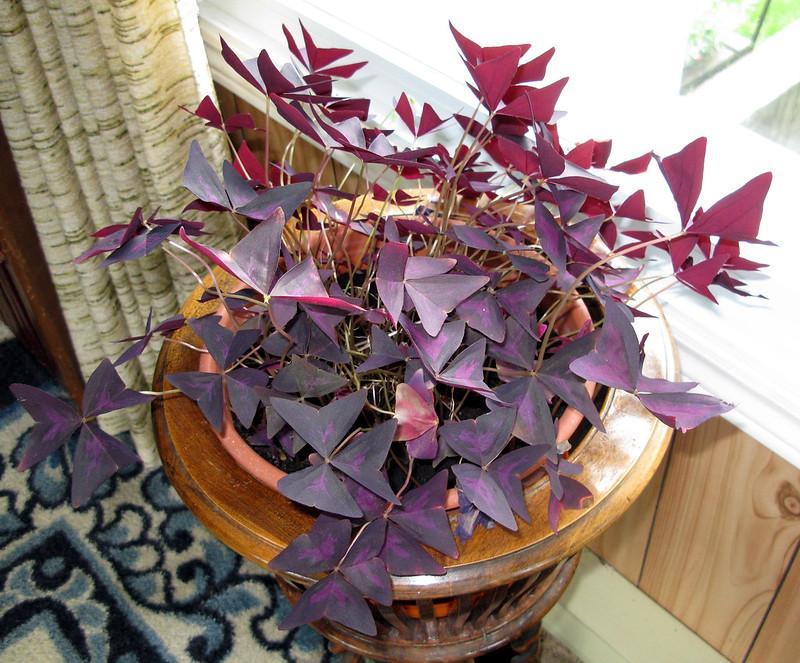
Does this look like a plant you might want in your home? If yes, click here.
This species of plant is indigenous to South America and can be found growing in woodlands and forests there. It has dark, edgy leaves that are shaped like triangles and grow in clusters of three. The leaves are a striking, deep purple color.
The purple shamrock is also edible and a superb vitamin C source for salads. Unfortunately, purple oxalis leaves will fold inward and resemble an umbrella at night or on overcast, gloomy days before reopening in the morning sun.
However, if you give purple oxalis a sunny place and keep the soil moderately moist, it is simple to maintain as an indoor plant.
Purple Shamrock Features & Basic Care
| Botanical Name | Oxalis triangularis |
| General Care | Easy to care for and cultivate, with little to no upkeep required. |
| Toxicity | Toxic to cats and dogs |
| Size & Growth | Mature plants are up to one foot in height and two feet in width |
| Blooms | Clumps of small pink flowers or white flowers |
| Propagation | Seed, roots, and stem cuttings |
| Fertilization | Add slow-release fertilizer only in the fall, winter, and spring. |
| Watering | Prefers consistent moisture. When the top inch of soil dries out, water it. |
| Humidity & Temperature | Temperatures between 60 °F and 75 °F and moderate humidity. |
| Light Requirements | Full to partial sunlight |
| Ideal Soil Type | Soil that is acidic has good drainage, is loamy, and sandy |
15. Purple Calatheas

Does this look like a plant you might want in your home? If yes, click here.
Calatheas are a must-have houseplant if you’re looking for anything with purple foliage. Calathea plants were first discovered in the deep shade of South American rainforests.
Leaves might be orange, green, pink, or white on the outside, but the insides are typically purple. And because it’s a praying plant, it’s always in motion.
The leaves of prayer plants close at night and unfold throughout the day, keeping them in constant motion. The pinnate shape and angular markings on the leaves of the calathea plant make them look like carved feathers. Calathea comes in several colors, so look for the purple and green ones in a gardening store or shop.
Purple Calatheas Features & Basic Care
| Botanical Name | Genus Calathea |
| General Care | Easy to care for and cultivate, with little to no upkeep required. |
| Toxicity | Not toxic to pets and humans |
| Size & Growth | Moderate or slow growth. Indoors, it reaches a height of around 2 feet. |
| Blooms | Produces yellow, white, and purple flowers throughout the summer |
| Propagation | Division and repotting |
| Fertilization | Use a general-purpose fertilizer once a month in the spring and summer. |
| Watering | Water after the top inch of soil has dried off (every 1 or 2 weeks) |
| Humidity & Temperature | Temperatures between 65 °F and 85 °F with high to moderate humidity |
| Light Requirements | Indirect sunlight with a medium to intense intensity |
| Ideal Soil Type | Soil that drains well and is porous |
Related: 20 Types of Calathea Plants that You Should Have in Your Garden
16. Chinese Evergreens
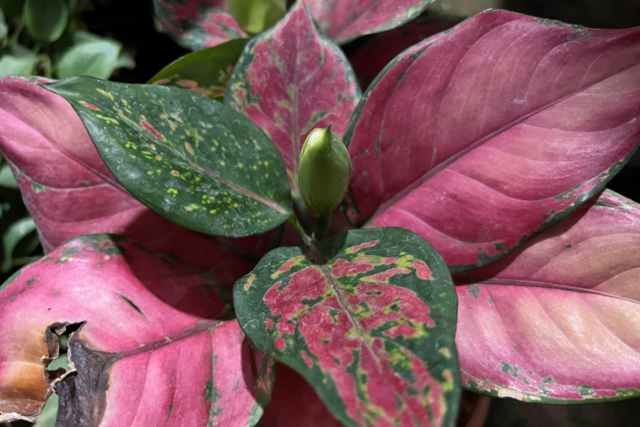
Does this look like a plant you might want in your home? If yes, click here.
Asians have grown Chinese evergreens for ages because they are believed to bring prosperity. However, they also make a delightful addition to the home as an indoor plant, thanks to the highly patterned foliage and the perpetual flowers that develop on mature plants. They are usually thick and leathery and can be any hue, from a deep purple to a silvery gray.
No matter where you choose to exhibit this easy-to-grow and low-maintenance houseplant – on the shelf or windowsill – it will offer a splash of color to any indoor space, provided that the plant is located in a somewhat shaded place.
Chinese Evergreens Features & Basic Care
| Botanical Name | Genus Aglaonema |
| General Care | Particularly challenging to grow in dry climates |
| Toxicity | Toxic to pets and people |
| Size & Growth | A slow-growing plant that can reach a height and width of two feet. |
| Blooms | Sort of heavy unattractive flowers |
| Propagation | Stem and leave cuttings |
| Fertilization | With slow-release fertilizer, feed once in the spring and once in the fall. |
| Watering | Likes wet soil. Water (and drain) thoroughly when the soil has dried out. |
| Humidity & Temperature | High humidity and temperatures over 65°F. Mist often or use a humidifier. |
| Light Requirements | Partial, indirect light |
| Ideal Soil Type | A potting soil that is acidic, peat-based, and well-drained |
17. Rex Begonia
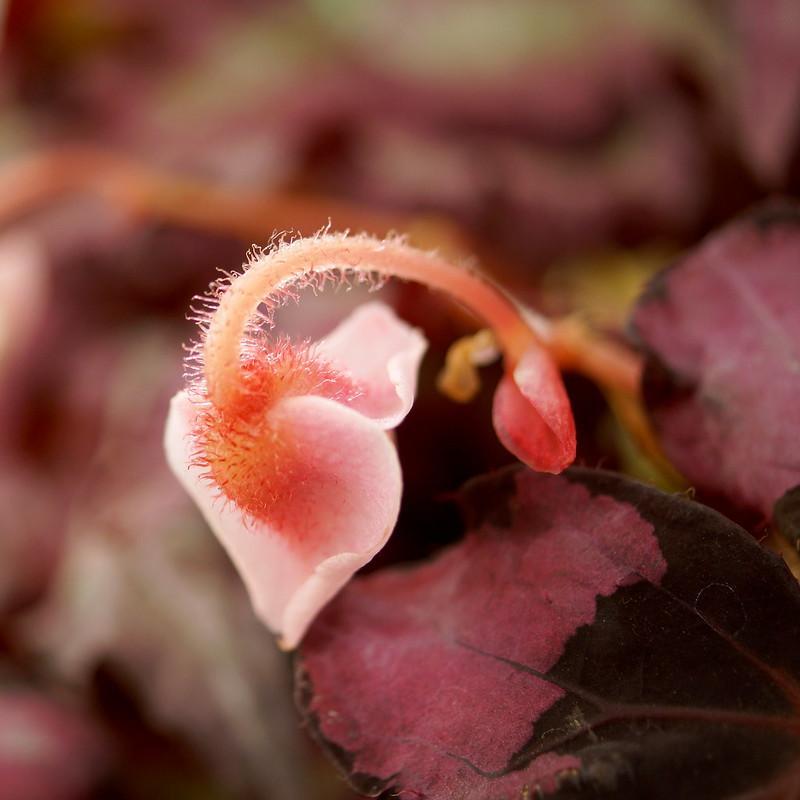
Does this look like a plant you might want in your home? If yes, click here.
Rex begonias are prized for their vibrantly colored and textured leaves. Rex Begonia plants are well known for their extremely attractive foliage and are sometimes referred to as fancy-leaf begonias or painted-leaf begonias.
The leaves feature a rainbow of hues and patterns, from solid purple to zebra stripes. Rex begonias are native to the dark understory of jungles and tropical rainforests.
They store vast amounts of water in their stems, which look like those of a succulent. Of course, you don’t have to make conditions exactly like a tropical rainforest for the plant to prosper, but it does, like high humidity, warm temperatures, and dim lighting.
Rex Begonia Features & Basic Care
| Botanical Name | Begonia rexcultorum |
| General Care | Producing visually appealing foliage requires careful cultivation. |
| Toxicity | Toxic to cats, dogs, and humans |
| Size & Growth | Typically grows to a height and width of between 12 and 18 inches. |
| Blooms | Showy flowers in the growing season |
| Propagation | Stem and leave cuttings |
| Fertilization | A dose of water-soluble, half-strength fertilizer once every two weeks |
| Watering | Consistent watering but prevent the soil from being overly saturated |
| Humidity & Temperature | Temperatures between 60 °F to 70 °F and moderate humidity |
| Light Requirements | Full to partial shade |
| Ideal Soil Type | A potting soil that has good drainage and is porous |
18. Prayer Plant
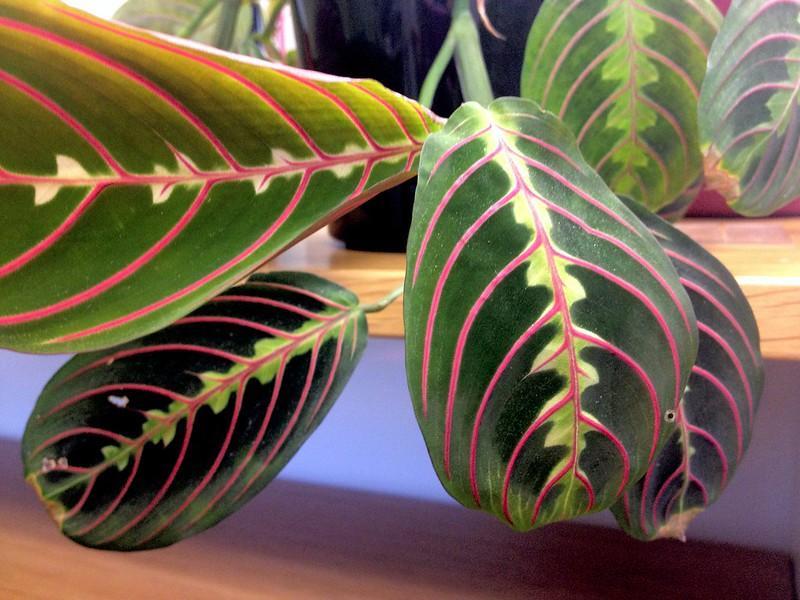
Does this look like a plant you might want in your home? If yes, click here.
The prayer plant is a fascinating houseplant because of the peculiar marks on its leaves, which are a purple-brown color. Depending on the type of plant, its leaves will have distinctive markings and colors.
It does well in consistently moist soil with humidity levels in the moderate to high range. These plants originate in tropical South and Central American woods.
Their peculiar name comes from the way the leaves, at night, fold up along the midrib seam, looking like a pair of praying hands. It has a beautiful texture, too, with fuzzy leaves that look and feel like velvet.
Prayer Plant Features & Basic Care
| Botanical Name | Prayer Plant |
| General Care | Not too hard to grow, so long as you pay attention to its specific needs. |
| Toxicity | Not toxic to pets and animals |
| Size & Growth | Plant grows slowly, reaching a height and width of around a foot at maturity. |
| Blooms | Rarely flowers |
| Propagation | Stem and leave cuttings |
| Fertilization | Half-strength fertilizer should be applied weekly from spring to fall. |
| Watering | When the top inch of soil has dried up, irrigate it with filtered water. |
| Humidity & Temperature | High humidity and temperature of 65 °F to 85 °F |
| Light Requirements | Partial to full shade |
| Ideal Soil Type | Acidic to neutral moisture-retaining soil |
19. Caladium
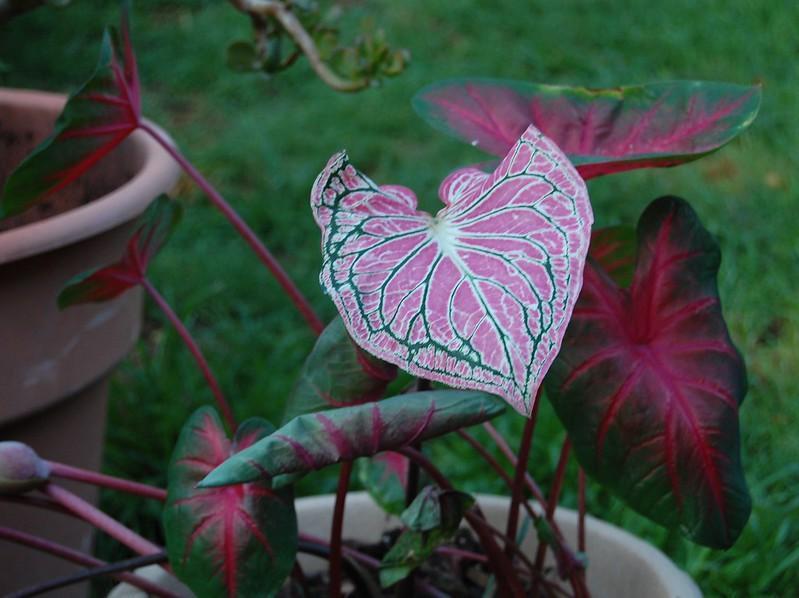
Does this look like a plant you might want in your home? If yes, click here.
Caladiums are stunning tropical plants with large leaves shaped like hearts and patterned with various colors. Some varieties, such as Caladium rubicundum bicolor, have a very lovely hue of purple with streaks of vibrant pink.
In their natural habitats, these plants can be discovered growing in the subtropical and tropical forests of South and Central America. Their leaves can be anything from 6 to 18 inches in length and reach a height of nearly 35 inches.
However, if they are maintained indoors as houseplants, they have a tendency to stay considerably smaller, and there are even dwarf types available. Bear in mind, also, some of these plants can be quite toxic to dogs and that if they eat the leaves, it might be fatal.
Caladium Features & Basic Care
| Botanical Name | Genus Caladium |
| General Care | Easy to care for and cultivate, with little to no upkeep required. |
| Toxicity | Some varieties are highly toxic to pets such as dogs and cats |
| Size & Growth | Can reach a height of up to 60 cm |
| Blooms | Usually does not flower indoors |
| Propagation | Tubar division |
| Fertilization | Apply a liquid fertilizer that is soluble in water once every two weeks. |
| Watering | Maintain moist soil during the growing season. |
| Humidity & Temperature | High humidity and temperatures of 60 °F to 70 °F |
| Light Requirements | 3-4 hours of filtered light per day |
| Ideal Soil Type | Rich, well-drained soil |
20. Coleus

Does this look like a plant you might want in your home? If yes, click here.
You can find coleus in many different colors and varieties, and it makes for a stunning display in any garden. The plant, which got its name from the Greek word for “sheath,” was a popular addition to Victorian-era gardens. The colors won’t be as vibrant if it doesn’t get enough sunlight. More light means more vibrant hues!
Coleus is endemic to the moist, shady, and warm conditions of the forests of Malaysia and Southeast Asia. Although it is primarily cultivated outside, a purple house plant is also an excellent choice for growing indoors. Many shades of purple-leaf coleus plants are available so you can collect them all.
Coleus Features & Basic Care
| Botanical Name | Genus Coleus |
| General Care | Easy to care for and cultivate, with little to no upkeep required. |
| Toxicity | Not toxic to pets and people |
| Size & Growth | Grow quickly and range in size from 1 to 3 feet |
| Blooms | Spiky tiny blue-to-white flowers |
| Propagation | Stem and leave cuttings |
| Fertilization | Fertilize during the spring and summer when the plant is actively growing. |
| Watering | Grow best in soil that is consistently moist but not soggy |
| Humidity & Temperature | Humid climate with 50 to 60% relative humidity & 50 °F 60 °F temperature |
| Light Requirements | Likes full sun but can handle partial or dappled sunlight |
| Ideal Soil Type | Prefers consistently moist, rich, loose, well-draining soil |
Final Thoughts
Purple house plants are a stunning complement to any decor and give your living area a vibrant flash of color. However, it can be challenging to focus your search when there are so many purple plants available. Each of these, from the exotic rainforest plants to the gentle, unassuming blossoms, is amazing in its own right and truly magnificent to look at.
So keep in mind that it’s ideal to choose plants whose maintenance requirements you are comfortable with and whose preferred habitat your house or office can readily provide.
Frequently Asked Questions (FAQs)
Why are my plant leaves turning purple?
Lack of phosphorus is the most common cause of a plant’s leaves turning purple instead of green. However, phosphorus shortage symptoms might also indicate that there is either an excess of water or that the soil temperature is too low. Both of these things decrease a plant’s capacity to take in phosphorus and use it for growth.
What causes purple leaves?
The presence of a pigment known as anthocyanin is typically responsible for giving leaves their purple color. This pigment enters the cell structure of the leaves and absorbs yellow as well as the green light, causing the foliage to take on a variety of different purple colors.
What is the meaning and symbolism of purple plants?
Purple flowers are often associated with affluence and even monarchy, but they can also convey respect and a sense of tradition. In addition, the naturally light purple flowers evoke feelings of peace and tranquility within you, and giving a bunch of lavender to someone you care about makes for the ideal present.
What plants have purple leaves?
There are many different kinds of plants with leaves that come in a variety of vivid purple colors. Some of our favorite purple plants include Prayer Plants, Purple African Violets, Campanula, Ti plants, Calatheas, Wandering Jew, Coleus plants, Purple shamrock, Gloxinia, Rubber Tree Plants, Moses-in-the-cradle, and many types of succulents.
What are the tall purple perennials called?
Phlox, often known as garden phlox, is a tall plant that belongs to the family Polemoniaceae. Because they require so little maintenance, these perennial flowers, which can be light or dark purple, are very popular. Bees and hummingbirds are also drawn to the plant due to the cluster of blooms it produces, which are vividly colored and give off a light scent.
Sources For Further Readings
Purple Plants – University of Florida, Institute of Food and Agricultural Sciences. (2022). Retrieved 15 October 2022, from https://gardeningsolutions.ifas.ufl.edu/plants/ornamentals/purple-plants.html
Purple Heart, Tradescantia pallida. (2022). , University of Wisconsin-Madison Division of Extension. Retrieved 15 October 2022, from https://hort.extension.wisc.edu/articles/purple-heart-tradescantia-pallida/
Purple Vegetables are Beautiful and Delicious. (2017). The University of Illinois. Retrieved 15 October 2022, from https://extension.illinois.edu/blogs/rhonda-ferrees-ilriverhort/2017-08-11-purple-vegetables-are-beautiful-and-delicious
Blue/Purple Flowers. (2022). Saint John’s University. Retrieved 15 October 2022, from https://www.csbsju.edu/outdooru/abbeyarboretum/landscape/plantsandwildlife/prairieplants/bluepurpleflowers
Editor’s Recommendations
What Type of Pothos Do I Have? Let Us Solve the Puzzle!
14+ Best Plants for South Window – VIP’s of the Blazing Sun
16 Best West-Facing Window Plants – Afternoon Sun Loving Beauties







